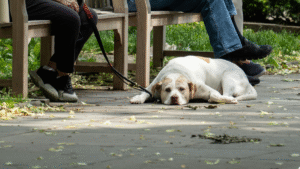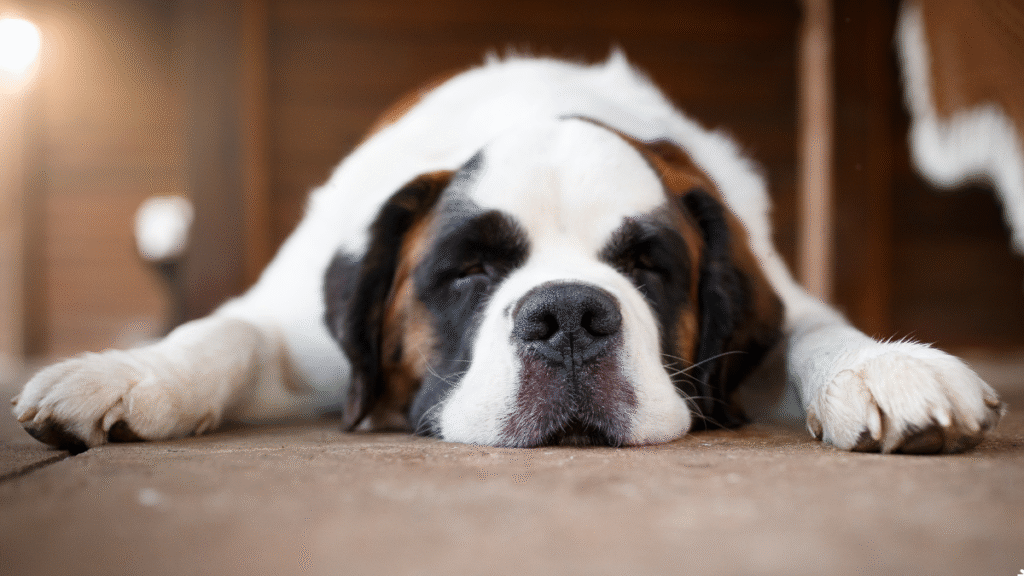Dogs fill our lives with fun, energy, and companionship. They’re always excited to play fetch, explore the backyard, or simply spend time with us. But sometimes, dogs need a break too! Just like humans, dogs can become tired—or even overtired. The question is, how can you tell? A tired dog might just need a nap, or they could be signaling that it’s time to slow down or even see the vet.

How To Know If Your Dog Is Tired
1. Your Dog Slows Down When Walking or Playing
One of the easiest ways to tell if your dog is tired is by observing how they move. A dog that used to race to the door at the sound of the leash or bolt down the sidewalk might slow their pace when fatigue sets in. If your dog starts walking more slowly, pauses frequently, or sits down mid-walk, they’re sending a clear signal—they need to rest.
Highly active dogs that don’t pause during walks or play sessions often need breaks too. Remember, weather conditions also affect how quickly your dog gets tired. On hot or humid days, shorten walks and limit time in the sun. Different dog breeds have varying exercise requirements, so factor that in when planning activities.
2. They Start Panting Heavily
Panting is normal for dogs—it’s how they regulate their body temperature. However, excessive panting when they’re not exercising or when the weather isn’t hot is a sign they’re overexerted. Heavy panting after activity means your dog needs to rest.
Signs include a hanging tongue, drooling, and rapid breathing. If panting continues even while resting, it could signal heat exhaustion. Move your dog to a cool area, provide water, and let them relax before resuming any activity.

3. They Lose Interest in Playing or Their Favorite Activities
A tired dog often loses enthusiasm for things they usually enjoy. If your dog normally leaps up when they see the leash or gets excited about their favorite toy but now ignores it, they’re likely tired and need downtime.
Don’t assume this only happens with older dogs. Mental exhaustion can be just as draining as physical activity. Visiting a new park, meeting other dogs, or being in a noisy environment can all wear your dog out. Give them a quiet space to unwind and recharge.
4. Their Body Language Changes
Just like humans, dogs communicate through body language. Common signs of a tired dog include:
-
Droopy or relaxed ears instead of perked-up ears
-
A tail that’s down or still instead of wagging
-
Heavy eyelids and slow blinking
-
Lying down or curling up more often than usual
Humans slouch or yawn when tired, and dogs display similar cues. Subtle movements—like ear position, tail carriage, or eye behavior—can all signal that your dog needs rest.
5. They Yawn Frequently
Does your dog yawn during walks, training sessions, or playtime? Yawning in dogs doesn’t always mean boredom—it’s often a sign of tiredness or mild stress.
A tired dog yawns to regulate brain activity and stay calm, just as humans do when sleepy. If your dog starts yawning repeatedly after being active, that’s their way of saying it’s time for a break.
Don’t worry if your puppy yawns often during play or training. Puppies tire quickly and need frequent naps. Keep sessions short to prevent frustration and overtiredness.
6. They Become Less Responsive
When dogs are tired, they’re less responsive than usual. They might take longer to obey commands or seem distracted when you call them. If your typically alert dog ignores their name or doesn’t show interest in you, they’re likely fatigued.
This is particularly noticeable during training. If your dog stops responding to familiar cues, it’s not necessarily stubbornness—it could be tiredness. Always end training sessions on a positive note to avoid stress or frustration for both of you.

7. They Seek Out a Quiet Spot
Just like people, dogs look for quiet, comfortable spaces to rest when they’re tired. Your dog might disappear under a table, retreat to their crate, or isolate themselves in another room. This is their way of telling you they need to unwind.
Resting is a natural and important part of a dog’s daily routine. Dogs can become mentally or physically fatigued after socializing or playing for long periods. Allow them some alone time without interruptions so they can fully recharge.
8. They Get Clumsy or Uncoordinated
A tired dog may become clumsy or lose coordination. If your normally agile dog starts tripping, misjudging jumps, or bumping into furniture, fatigue could be the cause.
This is particularly important for working dogs, agility dogs, and highly active breeds, where overexertion can lead to injuries. If your dog starts showing signs of physical fatigue, stop the activity, ensure they’re hydrated, and allow them to rest.

9. They Show Signs of Irritability
If your dog snaps at other dogs, resists petting, or growls when touched, they might be overtired and irritable. Irritability doesn’t always mean aggression—sometimes, it’s just a sign that your dog has had enough stimulation.
This behavior is common in puppies and young dogs, who can become cranky when they need a nap. If your dog becomes snappy, overly sensitive, or grumpy, it’s best to give them space and time to rest.
10. They Sleep More Than Usual
The most obvious sign of a tired dog is increased sleep. On average, dogs sleep between 12 and 14 hours per day, though puppies and senior dogs may need even more. If your dog spends most of the day sleeping after a busy outing, that’s normal recovery. However, if your dog remains excessively sleepy for several days, consult your vet.
Symptoms of an overtired or unhealthy dog may include:
-
Persistent sleepiness lasting several days
-
Difficulty waking up for meals, walks, or playtime
Excessive sleep for multiple days could signal health issues such as thyroid problems, infections, anemia, injury, or arthritis. Always rule out medical causes if your dog doesn’t bounce back after rest.
Helping Your Dog Recover from Fatigue
If your dog is overtired, the best thing you can do is let them rest. Here are a few easy ways to help your pup recover:
1. Provide a Comfortable Resting Area
Make sure your dog has a soft, quiet space away from noise and activity. A cozy bed or crate will help them relax and feel secure.
2. Hydrate After Exercise
Always offer fresh water after physical activity. Dehydration worsens fatigue and slows recovery. Allow your dog time to relieve themselves before settling down.
3. Feed a Balanced Diet
Good nutrition supports recovery and energy balance. High-quality food and supplements that promote digestion and joint health can improve stamina and reduce fatigue.
4. Monitor Exercise Levels
Every dog has different activity needs based on breed, age, and size. Track how much exercise your dog gets daily and adjust if they seem overly tired or restless.
5. Take Rest Days
Rest is just as important as exercise. Dogs don’t need intense activity every day. Alternate high-energy days with light activity or quiet time to help their bodies recover.
6. Pay Attention to Medical Issues
If your dog doesn’t seem to recover after several days of rest, consult your veterinarian. Persistent fatigue may be a sign of an underlying health problem.

The Difference Between Normal Fatigue and Medical Problems
Normal fatigue after exercise or excitement isn’t a concern. However, prolonged tiredness or changes in your dog’s normal behavior can signal something more serious. Look out for these warning signs:
-
Loss of appetite
-
Persistent coughing or heavy breathing
-
Limping, stiffness, or signs of pain
-
Pale gums
-
Sudden weight loss
-
Lethargy lasting more than 48 hours
If your dog shows any of these symptoms, contact your vet immediately. Many illnesses progress quickly in dogs, and early intervention is key to recovery.
Related:Diet Tips To Strenghten Your Dogs Teeth
Final Words
Dog tiredness should never be ignored. Overworked or overstimulated dogs can become stressed, restless, or even injure themselves. Paying attention to your dog’s energy levels, behavior, and body language helps you respond before fatigue turns into a problem.
Remember, dogs are like people—they need rest to stay healthy and happy. By recognizing the signs of tiredness and balancing activity with downtime, you’ll help your dog live a longer, more energetic, and joyful life.
- 5 Cheap Alternatives To Dog Training Equipment - November 12, 2025
- Homemade Calming Spray To Help Dogs During Training - November 12, 2025
- 7 DIY Dog Training Tools You Can Make From Household Items - November 12, 2025
